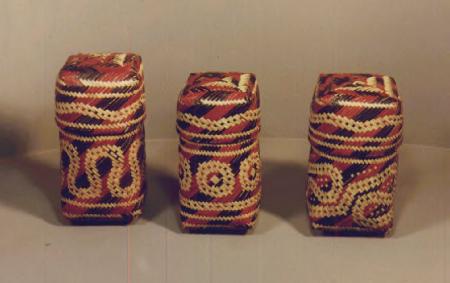|
|
Canku Ota |
|
|
(Many Paths) |
||
|
An Online Newsletter Celebrating Native America |
||
|
September 22, 2001 - Issue 45 |
||
|
|
||
|
Local Plant Seeks to Save Sugar Cane for Basket Weaving |
||
|
by Katina Gaudet Houma Today-September 17, 2001 |
 GOLDEN
MEADOW - South Louisiana's tribal people predate the arrival of European settlers. Although many tribes have endured
throughout the centuries. However, their members are having an increasingly difficult time keeping their traditions
alive. GOLDEN
MEADOW - South Louisiana's tribal people predate the arrival of European settlers. Although many tribes have endured
throughout the centuries. However, their members are having an increasingly difficult time keeping their traditions
alive.One such tradition is basket weaving, which is rooted in the origins of tribes such as the Chitimacha of Louisiana, the first federally recognized tribe in Louisiana. The Chitimacha date back to 800 B.C. and members still reside in the remnants of their ancestral homelands in St. Mary Parish. Local plant specialists, however, are lending their expertise to save a tribal tradition so ancient its origins are found in the earliest of Chitimacha tribal lore - basket weaving. For nearly a year, staff members at the Natural Resources Conservation Service's (NRCS) Plant Materials Center in Golden Meadow have been working with tribal members and plant specialists in St. Mary Parish to establish a dependable supply of native "river cane" - a woody species similar to bamboo that tribal members have been using for thousands of years. "River cane is the only plant we use to make baskets, and it goes back for generations," said John Paul Darden, a tribal basket maker and museum interpreter at the Chitamacha Museum in Charenton. "Our ancestors used the cane to make burial mats when we had mound burials, mats for huts, sifters (and more)." Tribal legends say basket weaving originated with the Great Spirit who left an unfinished basket in a walkway where a tribal member happened upon it. The Great Spirit told the woman if she wanted to learn more to return the next day. The woman did and, with the knowledge gained from the Great Spirit, completed the first basket. Due to the loss of aboriginal tribal lands, increased development and storm events, however, the river cane used in basket making is now in short supply, leaving tribal members looking for sources. Most known areas of river cane are found on private land, often making access difficult. Tribal members got in touch with NRCS staff in Franklin, who contacted staff in Golden Meadow and area landowners in an effort to re-establish a river cane supply. They obtained permission from landowners to dig up existing river cane and transplanted the cane in various ways at the center. "We're trying to figure out the best method to grow these. Then, we'll bring them back out into the field," said Gary Fine, manager of the center. The cane will be replanted on the Chitimacha reservation. "This plant center deals with wetland plants and wetlands conservation, so it's natural that it would help the tribe produce enough good, superior cane for use and to take those plantings on sites they select to increase the plantings," said Herb Bourque with NRCS's state office in Alexandria. Though an integral part of the tribe's history, basket weaving is now a skill practiced by a handful of tribal members, with only Darden, two of his family members and another tribal member taking part. There are a number of possible reasons for the drop-off in basket weavers, from the death of elder members to the dwindling cane resources and the time involved in weaving baskets. The preparation of the cane alone - the peeling and dying of the stalk - could easily take a week or more. And even smaller baskets could take at least two full workdays to complete, with larger baskets sometimes taking months. Chitimacha woven baskets are also complex, with 49 traditional patterns. These days, the baskets, originally woven for functional purposes, are more prized for their aesthetic value. "The designs and baskets are beautiful. People buy them now, and the baskets go on the shelf. I can't imagine people buying them to work with them," said Darden. Tribal members are hoping the increased river cane to come from the cooperative endeavor with NRCS will lead to a resurgence in basket weaving. They are hoping to plant the cane in late fall or early winter. |
|
Chitimacha Tribe of Louisiana |
|
|
||
|
|
||
| Canku Ota is a free Newsletter celebrating Native America, its traditions and accomplishments . We do not provide subscriber or visitor names to anyone. Some articles presented in Canku Ota may contain copyright material. We have received appropriate permissions for republishing any articles. Material appearing here is distributed without profit or monetary gain to those who have expressed an interest. This is in accordance with Title 17 U.S.C. section 107. | ||
|
Canku Ota is a copyright © 2000, 2001 of Vicki Lockard and Paul Barry. |
||
|
|
|
|
|
The "Canku Ota - A Newsletter Celebrating Native America" web site and its design is the |
||
|
Copyright © 1999, 2000, 2001 of Paul C. Barry. |
||
|
All Rights Reserved. |
||
